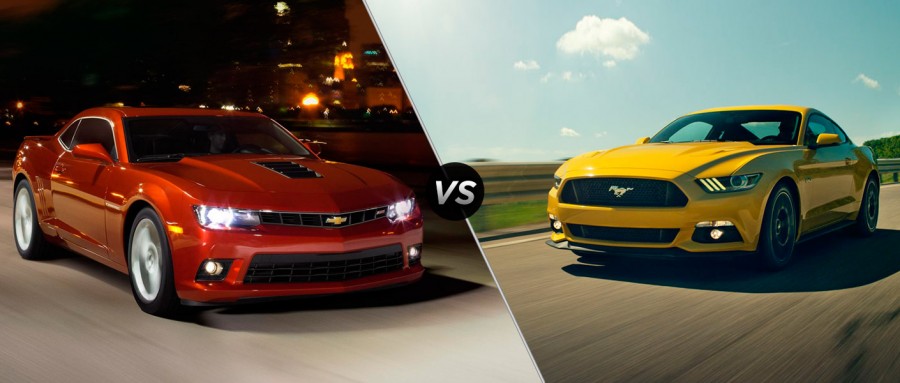Despite Rivalry, Mustang Trumps Camaro
Ford and Chevy have been rivals for decades, even before most of us were born, and out of that fierce competitiveness came two of the most popular muscle cars on the market: the Mustang and the Camaro. In 1964, the Ford Motor Company released the Mustang to the public. Needless to say, the pony car platform was a massive success. The Mustang was so popular, the Chevrolet Motor Company introduced the Camaro in 1967 — and the rivalry began.
The public began taking sides, some sticking with the original pony car and Ford, others preferring the larger Camaro and Chevy. Fans of the Mustang and Camaro tend to pick one car and stay on that company’s side, which prompts the age-old question, which is better — the Mustang or the Camaro?
To finally put to rest the debate of a generation, the newest, race-inspired versions of the cars, featuring the highest performance package the companies offer, have been stripped down to their performance specs for comparison. After analyzing tons of data, it is clear that while the 2015 Camaro Z/28 prevails in interior design, the 2016 Mustang GT350R dominates the Camaro in the power and performance aspect.
Both born in the mid-60s muscle car era, the biggest factor when choosing a favorite should be horsepower. While Camaro features the larger 7.0L V8 versus the Mustang’s 5.2L, the Mustang is rated with higher horsepower at 526 compared to the Camaro’s 505. According to Caranddriver.com, “A track-focused pony, the GT350 is powered by a naturally aspirated flat-crank 5.2-liter V8 that revs to the stratosphere.”
However, don’t underestimate the Mustang. It’s engine is the only flat-plane crank V8 offered in an American muscle car. Other than the engines, slight contrast exists between the two cars. Both feature a six-speed manual transmission and varying exterior amenities, such as spoilers and front splitters.
Race cars don’t only need power, they also need to perform. Race cars wouldn’t be race cars if they didn’t accelerate to high speeds very quickly. Luckily, both the Mustang and Camaro are two of the fastest cars in America. Although it may not seem like much, the Mustang smokes the Camaro in track performance by a close .2 second difference in quarter mile time and a .1 second difference in the 0-60 acceleration due to the Mustang’s lighter weight and more race oriented features*. The GT350R features a 3:73:1 gear ratio, which is ideal for most race cars.
In contrast, the Camaro features a 3:91:1, which should result in a better time due to shorter gear lengths. However, the Camaro’s weight slows it down enough for the Mustang to claim victory.
Aside from performance, a major factor in every car is driver comfort, especially in race cars. However, neither the Mustang nor Camaro were made for driver comfort. In fact, both cars don’t contain amenities, such as air conditioning and radio. Both companies had the same idea when it came to either car; shed as much weight as possible. As a result, both cars delete standard features such as air conditioning, radios, and sound systems.
The Mustang and Camaro also share specialty seats, short shifters, and drag style gauges*. However, Ford took the interior a step farther and deleted the rear seats and the spare tire. In contrast, the Camaro retains the rear seats but also includes a lavish sueded microfiber coating on the steering wheel, shifter, and dash. The microfiber adds more class and comfort to the car, which pushes the Camaro into the lead for driver comfort.
In conclusion, not only does the Mustang seem to win against the Camaro in terms of specs in every category but interior comfort — it also gives the buyer the most for their dollar. According to Chevrolet, the Z/28 Camaro’s starting price is approximately $72,305. The Mustang costs $20,000 less, starting at $52,995.
In conclusion, the GT350R packs more performance with a incredibly small price tag. So yes, the Mustang GT350R outperforms the Camaro Z/28 and burns a smaller hole in wallets.
*Specs, performance information, and option details obtained from Chevrolet, torquenews.com, motortrend.com, Autoevolution.com, and caranddriver.com.
















Brandon McGough • Jan 22, 2016 at 12:19 pm
While reading this article I knew most of what this writer is talking about such as the specs and comparable features. My comments are going to be somewhat bias because I’m a Ford guy at heart, I own a 2002 7.3L Ford F250 Powerstroke. Trying not to be bias I think the mustang is overall better because its pure performance. The reason why most people get a Camaro or Mustang is to go fast and have a race car, which making the mustang better. The Camaro has too much of the luxury end giving it a substantial amount of more weight giving the car a disadvantage to the Mustang. The mustang doesn’t have a the luxury the camaro does but if your looking for luxury then you should be looking at Cadillac’s. The Mustang is the way to go if your looking to sweep the streets of camaros.
Brandon McGough